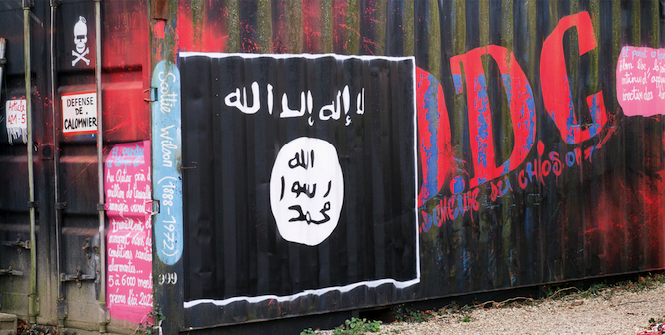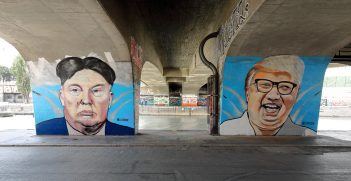When IS is not IS: Terrorism in Indonesia

Shortly after the 14 January terrorist attacks in Jakarta, the well-known Islamic State group (IS) claimed responsibility. These were the first major attacks targeting foreign interests in Indonesia since a series of suicide blasts at hotels in Jakarta in 2009. In a typically-worded statement, IS said that a group of its soldiers had targeted ‘Crusader citizens’ in the capital and warned that there is ‘no safety for [‘Crusader citizens’] in the lands of Muslims after today.’
Despite this, it is unlikely that IS actually had any direct role in the attacks in Jakarta. Unlike the recent high-profile attacks in Paris and Istanbul, none of the perpetrators of the attack had ever been to Syria or Iraq. It remains unclear whether the attackers had any tangible links at all with IS. To understand this, we must look at the structure of the group.
As has been typical of large terrorist groups in recent years, IS is organised in cells. The group’s main cell (or ‘IS-proper’) is undoubtedly the most familiar. It is based in Syria and Iraq and has been involved in a protracted conflict with the local governments, as well as with military campaigns against the group. Controlled by Ibrahim Awad Ibrahim Al-Badri, IS-proper provides ideological direction for the broader IS network and has highly-organised propaganda, recruitment and financing wings.
The broader network is made up of cells around the world. These cells are not financed by IS-proper and, beyond broader ideological directives, are not under its direct influence. So in most cases, these pledges of allegiance do not actually mean anything.
So if IS-linked groups weren’t responsible for the attack in Jakarta, then who was? To date, the only perpetrator of the January attacks to have been publicly identified by the police is Afif Sunakim, a 26-year old man from central Java. Sunakim had never been to Syria or Iraq and, as far as is publicly known, had no tangible links to IS-proper. Instead, Sunakim was reportedly radicalised whilst in a Jakarta prison. There, he came into contact with Aman Abdurrahman, a preacher whose ideology mirrors that of IS.
Following the attacks, the media speculated that Indonesian national Bahrun Naim was the ‘mastermind’. Naim travelled to Syria to fight with IS-proper in early 2015 and frequently praised IS in his blog posts. Following the attacks in Paris in November, he posted an article praising the planning, targeting, timing, coordination, security and courage of its perpetrators. Despite this, there is little evidence to suggest that he played an active role in perpetrating the recent attacks. Sidney Jones, director of Indonesia-based think-tank The Institute for Policy Analysis of Conflict (IPAC), recently cast doubt on claims that Naim was involved, saying ‘the Jakarta attack is now known to have been locally organised’.
The question remains whether it actually matters if the Jakarta attacks were conducted by IS-proper or IS-inspired actors. Understanding exactly who is responsible for the attacks forms a crucial part in countering the rise of the group. Each time IS-proper claims responsibility for an attack and are accepted claims, it legitimises the group. IS wants to appear to have the ability to conduct attacks all over the world, because this changes the way it is viewed and by extension, how we can counter it.
Today, IS has more than 40 cells in 20 countries. In Indonesia, only two groups have declared allegiance to IS-proper: Mujahidin Indonesia Timur and Jemaah Anshorut Tauhid. Neither group was responsible for the attacks in Jakarta in January nor has either demonstrated any capacity to mount attacks in major cities. The groups have instead focused on small-scale attacks in remote areas, suggesting they also lack the intent to target foreign interests.
At present, the most tangible terror threats in Indonesia are those presented by IS-inspired lone actors or more loosely-organised groups, rather than IS-proper or its cells. Without increased financial and operational support, both of which are unlikely, IS-affiliated groups like MIT and JAT will probably continue to present only a negligible threat. However, the threat presented by lone actors and groups will remain persistent.
The more loosely-organised nature of such individuals and groups means that it is much more difficult for the security services to detect and prevent terror plots. Jakarta demonstrated that a small group of like-minded men could go undetected and cause relative chaos in the centre of Southeast Asia’s largest city. Furthermore, lone wolf actors inspired by IS have proven their ability to conduct even more high profile attacks. Notable examples of this include the attempted attack on a train traveling between Belgium and France last August and the siege at the Lindt Café in Sydney in December 2014.
It is also likely that the problem of IS-inspired individuals is going to get worse before it gets better. Sidney Jones contends that, following the Jakarta attacks, ‘leaders of Indonesia’s tiny pro-ISIS camp are competing to prove their fighting credentials.’ On top of locally-based extremists, the problem of Indonesian fighters returning from Syria and Iraq will pose a significant challenge to the Indonesian authorities.
In late November, Indonesia’s intelligence agency said that about 900 citizens had travelled to Iraq and Syria to fight with IS-proper and that it was monitoring about 100 fighters who have returned home. The operational know-how that returnees may bring to what are otherwise poorly-organised and poorly-equipped local networks could prove pivotal in whether an attack is successfully implemented.
Thomas Murphy is a former terrorism analyst at a leading London-based political and security risk consultancy firm. He now works as a freelance analyst. This article is published under a Creative Commons Licence. It may be republished with permission.




